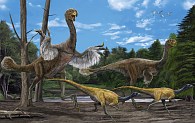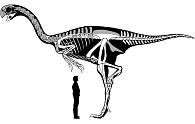2007年VOA标准英语-Massive New Dinosaur Fossil Unearthed in China
搜索关注在线英语听力室公众号:tingroom,领取免费英语资料大礼包。
(单词翻译)
By Jessica BermanWashington
13 June 2007
Chinese paleontologists have unearthed1 a massive dinosaur2 fossil in Mongolia. They say the giant dinosaur belonged to a family of bird-like dinosaurs3 that were a tiny fraction of its size. VOA's Jessica Berman reports.
 |
| Artist's drawing courtesy Institute of Vertibrate Paleontology and Paleoanthrology, Chinese Academy of Sciences |
The scientists say it had many of the same characteristics as the feathered dinosaurs known as oviraptors, which weighed only about 40 kilograms. But the enormous fossil belonged to a creature that was 300 times the size of an oviraptor. So, scientists are putting the giant dinosaur, which they are calling Gigantoraptor, in the same family.
The paleontologists say Gigantoraptor challenges theories of evolution that say as meat eating dinosaurs like tyrannosaurus got smaller, they became more bird-like.
David Burnham, a paleontologist at the University of Kansas, says the finding shows that diversity among dinosaurs is much greater than scientists had previously4 believed.
"We can't even imagine what evolution can provide at certain levels," he said. "And this is a really neat discovery to kind of show us, give us a window [into] what was going on during a critical time when birds were still primitive5 and you had multiple lineages of dinosaur-like birds developing at the same time."
 |
| Drawing courtesy Institute of Vertibrate Paleontology and Paleoanthrology, Chinese Academy of Sciences |
But as they studied the fossil, the Chinese researchers saw that the fossil had a beak6 instead of teeth.
"It's very difficult these days to sort of find a dinosaur that really surprises me, because there's just so much that we're still learning about these groups," said Hans Sues, associate director of research and collections at the National Museum of Natural History in Washington D.C.
He says the fossil of Gigantoraptor's beak and lack of teeth are physical features that made oviraptors excellent survivors7.
"These animals may have eaten some really unusual things like maybe seeds or eggs - people have proposed all kinds of ideas," he added. "There was some idea that some of the Mongolian ones were feeding on clams8. Some very unusual diet that didn't require teeth but did require this very odd jaw9 mechanism10."
The Chinese researchers say the enormous dinosaur also had sharp claws, possibly for tearing meat.
There is no evidence that Gigantoraptor had feathers, another characteristic that sets it apart from its oviraptor cousin.
The discovery of the gigantic fossil published this week in the journal Nature.
 收听单词发音
收听单词发音 




